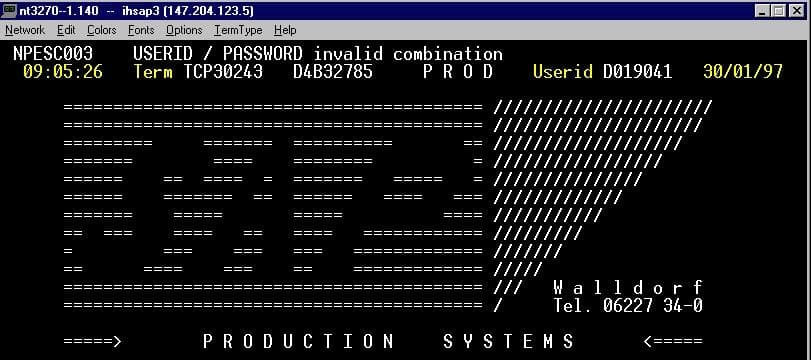What’s Accenture? And why is it worth $140B?
If you’re working at a tech company, you’ve probably thought about build vs. buy a lot — but what about build vs. outsource? Every year, companies spend more than $50B on tech and IT consulting. Particularly at larger companies and government organizations, tech problems can be big, complex, and annoying (would you want to re-do a data warehouse in Oracle?), and people don’t want to solve those problems themselves; so they’ll outsource it to companies like Accenture, who pulled in a cool $43B in revenue last year.
How did we get to these astronomical numbers? The history of tech and IT consulting is really the history of computers: companies like Accenture have been involved with building systems since the 1950’s, when getting company computers and networks running was a full time job, if not a miracle.
The story of Accenture starts with a fellow named Joseph Glickauf Jr., who after a stint in the Navy’s research division was recruited by Arthur Andersen to conduct a feasibility study. The Andersen name might sound familiar — Arthur Andersen was one of the world’s largest multinational businesses by the turn of the century ($9B in revenue in 2002). Back in the early 50’s, it was mostly an accounting firm; but like many other businesses at the time, they were looking to expand into the computing wave.
Back to Mr. Glickauf, our protagonist. The feasibility study he was hired to conduct was for GE’s Appliance Park in Louisville: the question was whether an electronic computer could help automate some of their manual processes. This installation ended up being the first ever for a U.S. business, and this was just the beginning for GE: they would end up getting deeply involved in the computing ecosystem.) and competing with IBM in the 60’s. Yes, you read that right: the first ever successfully installed computer for a U.S. business owes its origins (via a feasibility study) to consultants.

There’s one curious thing, though: what was an accounting firm doing conducting feasibility studies for computers? The two are actually more related than you might think; in the early days of computers, basic financial arithmetic was actually one of the most common use cases around, along with automated payroll and billing tasks. Glickauf’s standard demo was just an electronic counting machine that could perform 600 calculations per second. The reality is that for a while, computers were basically giant calculators, and so they were actually a completely natural extension for accounting firms like Andersen. The fact that these computers were so difficult to understand and extract value from created the perfect environment for a firm like Andersen to grow.
Around the start of the 50’s, Arthur Andersen was pulling in around $6.5M ($70M in 2020 dollars). But technology consulting — kicked off with this GE project — would come to define the company in the following decades. In the 70’s, the firm expanded their tech consulting to systems integration, application development, and strategic services. By 1988, Andersen was the largest consultancy in the world, and 40% of the entire company’s revenue came from consulting operations. There’s no publicly available data on how much of that revenue was from _technology _consulting as opposed to other forms, but there’s little doubt that tech consulting was a driving factor for this remarkable growth.
Success doesn’t come without consequences (as they say), and the burgeoning consulting powerhouse inside Arthur Andersen was no exception. As the consulting business continued to grow, more internal conflicts began to plague the company: auditors and consultants were in constant disagreement about pay scale and how consulting operations should be managed. Consultants were frustrated that they brought in more money per project (often four or five times as much as an audit), but consulting projects were still managed by accounting partners. Even though revenue ballooned to $51M by the early 70’s ($400M in today’s dollars), growth didn’t seem to solve all problems here.
In the late 80’s, tensions came to a head. A few particularly angry consulting partners left the company, and leadership finally decided to split up Arthur Andersen into two entities: one for tax and audit (Arthur Andersen & Company) and one for consulting (Andersen Consulting). Both of these entities were part of a parent company, but they had little to do with each other in terms of day to day business.

The split smoothed things over for a bit, but didn’t solve the problem. The accounting branch started to take on small consulting engagements, the disparity in fee contributions continued to widen, and consulting partners continued to threaten quitting. The case finally went to The International Court of Arbitration in Paris in 2000, and the court ruled that the two entities should be completely split. Andersen Consulting changed its name to Accenture in 2001, raised $8B in an IPO, and the saga was over. But the story doesn’t end there: this final split for Accenture ended up being _incredible _timing.
Enron was formed in 1985, and was a pretty nondescript energy and gas trading company in their early years — if you’ve heard of them, it’s probably because they were responsible for one of the biggest financial scandals in U.S. history. After the company soared to a $90 share price and one of the largest market caps in the world at the time, investigators discovered that Enron leadership had been lying about their numbers for years ($100B in fake revenue), and their auditor — none other than Arthur Andersen & Company — had been actively complicit. The Jury’s 2002 verdict effectively barred Andersen from practicing, and even though the conviction was overturned 3 years later, the firm was all but dissolved. Had Accenture not split off just a year before this, it’s unclear if they’d still be around today.
The Accenture drama extended into the new century, but the 90’s was when IT consulting really started to take off. In addition to the rapid growth of what’s now Accenture, IBM’s Global Services Group — the computing giant’s technology consulting arm — was picking up steam. A 2002 merger with a PWC subsidiary brought IBM up to 60,000 consultants, and today this part of the business generates $27B in yearly revenue. A little known company named Infosys went public in ‘93. It was a good time to be in the consulting business.
All of this (dramatic) history raises the question: what do these firms actually do?
Tech consulting firms like Accenture are used for outsourcing large engineering projects. Building new, user facing applications is a relatively small part of engineering at larger companies: working with and maintaining existing legacy systems can take up the lion’s share of engineering time. Data integration, implementing large pieces of software like ERP, or unifying disparate applications or systems are critical work, but there are a few problems:
- Companies don’t always want to do this work (it’s ugly and time consuming)
- Companies can’t always do this work (it’s difficult and requires specialized expertise)
- Companies shouldn’t always do this work (it could be cheaper to outsource)
In these kinds of situations, you might hire a consulting firm to build a solution for you instead of implementing it yourself. This is not your typical indie dev shop work: Accenture contract sizes are almost always _at least _in the multiple millions and routinely exceed $1B. In 2015, Accenture won part of a $4.3B contract from the Department of Defense to rebuild the Military Health System’s electronic records application. Yes, you read that number correctly.
To get a better sense of what work Accenture and firms like it actually do, lets run through a few of Accenture’s recent contracts:
- SCOR– Accenture helped the French reinsurer integrate ServiceNow to automate quarterly closes.
- UCB – Accenture worked with the biopharmaceutical company to implement Machine Learning that manages the clinical trials process.
- Navantia – Accenture helped the Spanish shipbuilder implement a digital twin system to improve their visibility and analytics.
- Santen Pharmaceutical – Accenture worked with Santen to implement SAP as their ERP platform.
While most of the big contracts you’ll see in tech consulting are related to these kinds of big, legacy systems, that’s not the only thing companies like Accenture do; they also build apps and websites, but at a larger scale. A great example is Accenture’s recent (high profile) contract with Hertz: they were tasked with building Hertz a new website and mobile app. This kind of implementation work is very similar to what you’d expect a dev shop to work on.
The Hertz contract had just one twist: it was worth more than $30M. Hertz’s goal was ambitious — they wanted to “redefine the customer experience” through a “market-leading website at Hertz.com and a complementary suite of mobile applications” — they just didn’t have the internal expertise to actually get it done. Accenture — along with IBM and similar tech consulting firms — fills in that gap with their own software engineers, and that’s what they did for Hertz.
Note: Hertz has since filed a $36M suit against Accenture for a flawed digital initiative
It’s important to note that while Accenture’s origins lie in technology and IT consulting, the kind of work that firms like Accenture do isn’t black and white - Accenture is a full service consulting firm, and technology consulting is only a part of the picture. They also do management consulting, healthcare consulting, and government consulting; all which often overlap with implementing technical solutions.
Subscribe to the Retool monthly newsletter
Once a month, we send out top stories (like this one) along with Retool tutorials, templates, and product releases.
Accenture had $44 billion in revenue in 2020, with most of it coming from enterprise and government contracts. According to Accenture, their clients “span the full range of industries around the world and include 91 of the Fortune Global 100 and more than three-quarters of the Fortune Global 500.”
We found a proposed statement of work that Accenture submitted to the Georgia Department of Community Health, totaling $2.4 million over seven months (141-page PDF here).
What exactly goes into a multi-million dollar Accenture engagement? Here’s the outline:
Objectives
The Georgia Department of Community Health (DCH) invited Accenture to submit a proposal to develop two applications that would allow people to qualify for waivers under section 1115 of the Social Security Act and section 1332 waivers under the Affordable Care Act. If selected, Accenture would provide guidance and the actual applications, which would be sent to the federal government to expand Georgia's Medicaid program and offer a private health insurance marketplace through an alternative to the Social Security Act and Affordable Care Act.
Objectives from Accenture’s proposal:
- conduct a scan of the current Section 1115 and 1332 Waiver environment and the current national healthcare environment;
- summarize key opportunities to utilize Section 1115 and 1332 Waiver authority to maximize federal flexibility affecting program implementation and operation;
- conduct a Georgia-specific environmental scan;
- develop up to three (3) viable Section 1115 Waiver options and up to three (3) viable Section 1332 Waiver options, all of which support the State’s policy goals;
- produce and formally submit the Section 1115 and 1332 Waiver applications based upon the preferred approach and policy options selected by the Governor; and
- when appropriate, respond to any Requests for Information sent by CMS and/or the United States Treasury.
Timeline and output
Accenture's proposal to the DCH outlines three phases of work that ultimately result in formal Section 1115 and 1332 waiver applications being sent to the federal government.

Key deliverables at each stage (pulled directly from the proposal):
- Summary Report — This report will detail the results of the national and Georgia environmental scans performed during Phase 1 and will be delivered at the end of Month 1.
- Waiver Options Report — This report will be issued in the middle of Month 4 and will include detailed descriptions of the three waiver options as well as a recommended option identified in collaboration with the state core team. The Waiver Option Report would support selection of a chosen option by the Governor’s Office at the beginning of Month 5 (i.e., project milestone 1).
- Draft Waivers — Draft versions of the waiver(s) requested by the Governor’s Office. These waivers support the public comment period and would be produced at the beginning of Month 6.
- Formal Section 1115 and 1332 Waiver Applications — These are the final versions of the Section 1115 and 1332 waiver applications and would include approved feedback to be incorporated during the state core team review and public comment periods. These waiver applications would be available no later than the end of Month 7 (i.e., project milestone 2).
Team
Accenture would assemble a team of 20 "significant, respected subject matter advisors in Medicaid and waivers” to offer guidance and produce key deliverables. This team of experts would include a former chief of staff for the US Department of Agriculture, healthcare analysts and consultants, and policy advisors.
If each team member worked full time on this contract for 7 months (20 people * 40 hrs/wk * 28 wks = 22,400 hrs) the average hourly rate would be $107/hrs ($2,400,000/22,400 hrs).

Behind the scenes of large contracts are large problems. The agency incentive problem is as old as time: when you get paid per hour worked, you’re incentivized to bill more hours and get paid more. Accenture’s business model can sometimes be completely misaligned with its customers, and that has led to inflated contract values, delayed timelines, and unfortunately often, legal troubles.
The problem starts with the client: in a lot of these cases, large organizations and governments are offloading problems to Accenture because they don’t want to deal with them or they’re not really solvable – IT consulting firms can be set up to fail from the start. Accenture’s incentive is to minimize the hours worked, and maximize the hours billed; so they’ll often try to reuse a sub-optimal solution they’ve built for a different client, and set up the system such that it will need a ton of ongoing maintenance that they can bill for. With operating margins as slim as 15%, every hour saved in cost has meaningful implications, which is also why more than 30% of Accenture’s workforce is situated in lower cost labor markets like India.
And then there are the legal troubles. That quote above about Hertz’s ambitions was taken from the lawsuit they eventually filed against Accenture after the consultant allegedly failed to deliver on the site and the mobile app.

Investigations like this are a commonplace part of IT consulting, especially when the government is a client: the larger contracts get, the more is at stake and the larger the sunk cost. A huge Accenture contract with the State of California was slammed by the State Auditor after coming in hundreds of millions of dollars over budget. A similar gaffe happened in England with a multi-billion dollar NHS IT overhaul where Accenture was the primary contractor.
Obviously, not every IT consulting engagement ends in turmoil - there’s a good reason why Accenture has gotten so large and been so successful, and it’s because they generally provide value to their clients. But the technology world has changed a lot over the past decade, and it’s worth thinking about how much of the value firms like Accenture provide is just a place to offload legacy system projects and someone to blame when they inevitably go wrong.
Those giant contracts eventually add up. Today, Accenture employs five hundred thousand people — and while they’re the biggest firm by number of employees, they’re not some crazy outlier. Tata, an India-based consultancy (among other things) employs 400K; in fact, there are 8 tech consulting firms just in India that employ more than 100K people. For some context, Google employs around only 120K full time people. Facebook has around 50K. The scale of these consultancies is massive.
If you work at a tech startup, chances are you’re not going to come across Accenture consultants in your day to day. The prime clientele for IT consulting are massive companies with traditional lines of business and legacy infrastructure, not fast moving startups. Accenture is one of Oracle’s largest clients and system integrators, and there were even rumors of an acquisition a few years ago.
Another key client demographic for IT consulting is the government. Search Google for “Accenture government consulting” and you’ll find entire results pages filled with specialized Accenture content targeted at the public sector.

Accenture doesn’t break out their revenue by client type, but their engagements with the Federal Government go through a special subsidiary, and some back of the napkin math from this year’s annual report indicates around $2.5B in revenue just from here. Other state or local government contracts can go for $1B+ too.
Tech consulting definitely does have its bright spots. Accenture has smaller divisions like Accenture Interactive that work on pretty cool stuff, like a partnership with Disney on a new innovation lab and a collaboration with Apple on iOS business solutions. And if you’re a new college grad, associate positions can be fast ways to learn engineering on the job and get exposure to large scale systems that you wouldn’t otherwise work with.
Looking in from startup land, it’s easy to look at these massive organizations as a remnant of legacy technology and wasteful corporate bloat, but it’s not all negative. Any company generating billions of dollars in revenue is probably doing something right. The reality is that even though a lot of these projects end in disaster, companies like Accenture provide valuable services to a lot of their clients; and in certain situations (especially when Oracle is involved), they really are the best option on the table.
Reader



